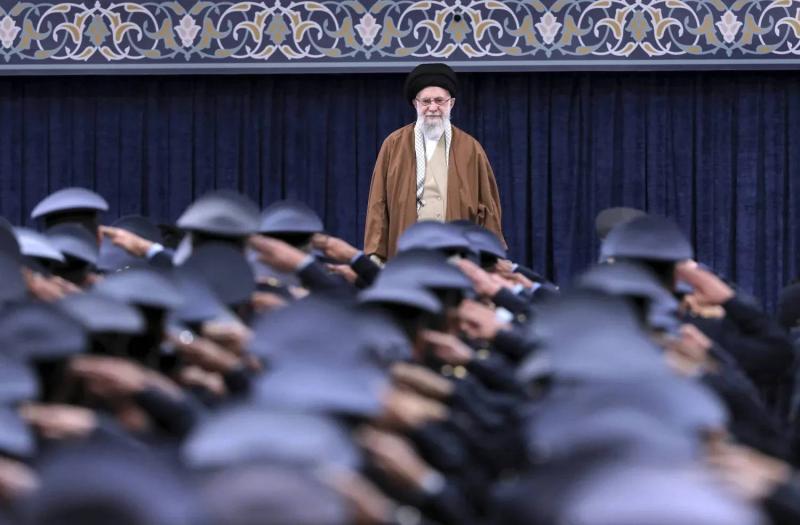Iran is a large and ancient country. The region has an interest in seeing it stable and prosperous, away from threats to close the Strait of Hormuz and the sponsorship of Houthi missiles in the Red Sea. The Khomeini Revolution was not merely a major coup in Iran; it carried within its constitution the project of a coup against regional balances, with a clear clause on exporting the revolution. It is no exaggeration to say that the Middle East has been experiencing the longest upheaval in its history since the revolution’s victory in 1979. The Iraq-Iran war halted this upheaval for eight years, only for it to resume afterward. Saddam Hussein used to say that the fall of the Iraqi wall would extend Iranian influence to the borders of Morocco.
The Khomeini Revolution was born on the frontline with the "Great Satan." Supreme Leader Ali Khamenei surely remembers the old scenes vividly. Revolutionaries stormed the American embassy in Tehran and humiliated the "American giant" in the longest hostage-taking operation. He can also recall 1983 when Beirut awoke to two massive explosions targeting the Marine barracks and the French unit in the multinational force, resulting in hundreds of deaths. The "Great Satan" carried the bodies of its soldiers and withdrew from Lebanon. Not forgotten is what occurred in 2006—a war between Hezbollah and Israel, managed by General Qasem Soleimani from Lebanese soil. This conflict broke the siege around Hezbollah and Syria after the assassination of Rafik Hariri. Soleimani also orchestrated the attrition of the American occupation in Iraq and initiated the era of factions in Baghdad.
Khamenei can recall many successes, such as saving President Bashar al-Assad from the fate that befell Muammar Gaddafi, Ali Abdullah Saleh, Hosni Mubarak, and Zine El Abidine Ben Ali. He himself heard his generals boast that the keys to four Arab capitals reside in Tehran.
The Supreme Leader can also reflect on other scenes. Barack Obama was eager to strike a nuclear deal with Iran. Iranian negotiators succeeded in excluding regional activity and missile arsenals from negotiations. Following the major upheaval, the fall of Saddam Hussein paved the road from Tehran to Beirut, passing through Baghdad and Damascus. The killing of Soleimani by order of Donald Trump in his first term was a significant blow, but it did not stop the project of upheaval nor close the road.
Despite its economic troubles, Iran did not hold back on providing its proxies with weapons and funding. It was thrilled to encircle territories with missiles and drones. Tehran felt that the faction empire was now beyond threat and promised expansion. It believed that Israel was incapable of bearing the costs of a major war and that America, preoccupied with China's rise, would not engage in a costly major upheaval in the Middle East. Iran and its allies underestimated America's deep commitment to Israel’s security. When Yahya Sinwar launched "Al-Aqsa Flood" followed by Hassan Nasrallah with the "support front," it was believed that the “major blow” had begun.
Fortunes change. Suddenly, Iran found itself facing the other side. Horrifying scenes and painful news emerged. It was no small matter for Israel to assassinate Hamas leader Ismail Haniyeh in Tehran itself, nor was it insignificant for Gaza to be awash in blood without Iranian salvation. More painful was Nasrallah’s assassination in Beirut, with Iran unable to save Hezbollah. Houthi missiles moved but did not come to the rescue in Gaza or Lebanon. Iran saw its regional defense lines crumbling. Hamas suffered a significant blow, and the same was true for Hezbollah, with the Syrian link loss even greater. Israeli planes attacked Iran and destroyed its air defenses, revealing that continuing mutual strikes resembled falling into a trap Iran always sought to avoid—war with America.
It is clear today that America and Israel responded to Iran's latest upheaval with a major shift to alter previous regional balances. Tehran now hears Israeli defense ministers tying Beirut's security to that of the Galilee. Hezbollah cannot return to war—not only due to the blows it received and the majority of Lebanese demanding the state hold arms exclusively, but also because the name now in the Syrian presidential palace is Ahmad Al-Shara, not Bashar al-Assad.
These are the hardest days for the Supreme Leader. Trump is demanding a response to his message within weeks. He practically offers Iran a return to its own borders. The intense American raids on Houthi sites are daily hot messages directed at the Supreme Leader and his country. Trump did not speak of overthrowing the Iranian regime. He merely requires Iran to retreat back within its borders and abandon the dream of the bomb and parallel armies it maneuvered regionwide. While Hamas may not give up its arms, it is forced to exit the military aspect of the conflict for years. Hezbollah faces similarly tough choices. Trump awaits the Supreme Leader’s response, threatening "bad things" for Iran and unprecedented bombing if the response is negative.
These are the toughest days for the Supreme Leader. Iran's image in the region is not what it was before the "flood." His decision affects his country and the region, and the new balances do not favor Tehran. Once, Khomeini agreed to swallow the poison cup and accepted a ceasefire, relinquishing the dream of toppling the "infidel Baath regime in Iraq." Will Khamenei agree to swallow the poison of accepting a return of Iran to its own borders, without a bomb and without arms?



